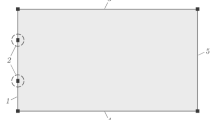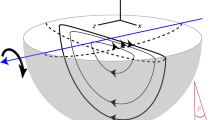Abstract
Viscous fingering is one of the most important factors to produce realistic diffusion among two miscible fluids with differing viscosities. Diffusion-limited Aggregation (DLA) has been a popular choice for the synthesis of the viscous fingering effect. However, as DLA provides a mere description of aggregation process, it is not clear how to apply the DLA model into conventional 3D fluid simulation equations. The DLA model first generates a shape description of the viscous fingering effect. The shape description is changed to a fluid flow region by the application of dilation and erosion operators. The flow region is then filled with the directions which will guide the fluid motion in a simulation. The directions are converted into a form of external force by means of a linear feedback system. Our results show that the DLA model can generate the viscous fingering effect effectively in a single phase simulation without relying on a high resolution grid. Our method is semi-physical due to the employment of DLA and is easy to implement, as the underlying concept is simple. Computational overhead is also negligible from the conventional fluid simulation.










Similar content being viewed by others
References
Becker, M., Teschner, M.: Weakly compressible sph for free surface flows. In: SCA’07: Proceedings of the 2007 ACM SIGGRAPH/Eurographics Symposium on Computer Animation, pp. 209–217 (2007)
Bogoyavlenskiy, V.A.: Mean-field diffusion-limited aggregation: A “density” model for viscous fingering phenomena. Phys. Rev. E 64, 066303 (2001)
Chan, D.Y.C., Hughes, B.D., Paterson, L.: Fluctuations, viscous fingering, and diffusion-limited aggregation. Phys. Rev. A 34, 4079–4082 (1986)
Fedkiw, R., Stam, J., Jensen, H.W.: Visual simulation of smoke. In: SIGGRAPH’01: Proceedings of the 28th Annual Conference on Computer Graphics and Interactive Techniques, pp. 15–22 (2001)
Foster, N., Metaxas, D.: Realistic animation of liquids. Graph. Models Image Process. 58(5), 471–483 (1996)
Gonzalez, R.C., Woods, R.E.: Digital Image Processing. Addison-Wesley, Reading (1993)
Gunzburger, M., Manservisi, S.: Analysis and approximation for linear feedback control for tracking the velocity in Navier–Stokes flows. Comput. Methods Appl. Mech. Eng. 189(3), 803–823 (2000)
Hong, J.m., Kim, C.h.: Controlling fluid animation with geometric potential. Comput. Animat. Virtual Worlds 15(3–4), 147–157 (2004)
Hong, J.M., Kim, C.H.: Discontinuous fluids. In: ACM SIGGRAPH 2005 Papers, SIGGRAPH’05, pp. 915–920. ACM, New York (2005)
Hong, J.M., Lee, H.Y., Yoon, J.C., Kim, C.H.: Bubbles alive. ACM Trans. Graph. 27, 48:1–48:4 (2008)
Kang, N., Park, J., Noh, J., Shin, S.Y.: A hybrid approach to multiple fluid simulation using volume fractions. Comput. Graph. Forum 29(2), 685–694 (2010)
Kim, T., Lin, M.C.: Fast animation of lightning using an adaptive mesh. IEEE Trans. Vis. Comput. Graph. 13, 390–402 (2007)
Kim, T., Henson, M., Lin, M.C.: A hybrid algorithm for modeling ice formation. In: Proceedings of the 2004 ACM SIGGRAPH/Eurographics Symposium on Computer Animation, SCA’04, pp. 305–314. Eurographics Association, Aire-la-Ville (2004)
Kim, B., Liu, Y., Llamas, I., Rossignac, J., Flowfixer: Using bfecc for fluid simulation (2005)
Kim, Y., Machiraju, R., Thompson, D.: Path-based control of smoke simulations. In: Proceedings of the 2006 ACM SIGGRAPH/Eurographics Symposium on Computer Animation, SCA’06, pp. 33–42. Eurographics Association, Aire-la-Ville (2006)
Kim, B., Liu, Y., Llamas, I., Rossignac, J.: Advections with significantly reduced dissipation and diffusion. IEEE Trans. Vis. Comput. Graph. 13(1), 135–144 (2007)
Kim, D., Song, O.y., Ko, H.S.: A semi-lagrangian cip fluid solver without dimensional splitting. Comput. Graph. Forum 27(2), 467–475 (2008)
Leonard, B.P.: A stable and accurate convective modelling procedure based on quadratic upstream interpolation. Comput. Methods Appl. Mech. Eng. 19(1), 59–98 (1979)
Losasso, F., Talton, J., Kwatra, N., Fedkiw, R.: Two-way coupled sph and particle level set fluid simulation. IEEE Trans. Vis. Comput. Graph. 14(4), 797–804 (2008)
Monaghan, J.J.: An introduction to sph. Comput. Phys. Commun. 48(1), 89–96 (1988)
Monaghan, J.J.: Simulating free surface flows with sph. J. Comput. Phys. 110, 399–406 (1994)
Park, J., Kim, Y., Wi, D., Kang, N., Shin, S.Y., Noh, J.: A unified handling of immiscible and miscible fluids. Comput. Animat. Virtual Worlds 19, 455–467 (2008)
Saffman, P.G., Taylor, G.: The penetration of a fluid into a porous medium or Hele–Shaw cell containing a more viscous liquid. Proc. R. Soc. Lond. Ser. A, Math. Phys. Sci. 245(1242), 312–329 (1958)
Sethian, J.: Level Set Methods and Fast Marching Methods. 3. Cambridge University Press, Cambridge (1999)
Shin, S.H., Kim, C.H.: Target-driven liquid animation with interfacial discontinuities. Comput. Animat. Virtual Worlds 18, 447–453 (2007)
Shin, S.H., Kam, H.R., Kim, C.H.: Hybrid simulation of miscible mixing with viscous fingering. Comput. Graph. Forum 29(2), 675–683 (2010)
Song, O.Y., Shin, H., Ko, H.S.: Stable but nondissipative water. ACM Trans. Graph. 24, 81–97 (2005)
Stam, J.: Stable fluids. In: SIGGRAPH’99: Proceedings of the 26th Annual Conference on Computer Graphics and Interactive Techniques, pp. 121–128 (1999)
Stam, J.: Real-time fluid dynamics for games (2003)
Takahashi, T., Fujii, H., Kunimatsu, A., Hiwada, K., Saito, T., Tanaka, K., Ueki, H.: Realistic animation of fluid with splash and foam. Comput. Graph. Forum 22(3), 391–400 (2003)
Tamas, V.: Fractal Growth Phenomena. World Scientific, Singapore (1992)
Treuille, A., McNamara, A., Popovi, Z., Stam, J.: Keyframe control of smoke simulations. In: SIGGRAPH’03: SIGGRAPH 2003 Papers, pp. 716–723 (2003)
Witten, T.A., Sander, L.M.: Diffusion-limited aggregation, a kinetic critical phenomenon. Phys. Rev. Lett. 47, 1400–1403 (1981)
Xu, S., Mei, X., Dong, W., Zhang, Z., Zhang, X.: Interactive visual simulation of dynamic ink diffusion effects. In: Proceedings of the 10th International Conference on Virtual Reality Continuum and Its Applications in Industry, VRCAI’11, pp. 109–116. ACM, New York (2011)
Yabe, T., Aoki, T.: A universal solver for hyperbolic equations by cubic-polynomial interpolation I. One-dimensional solver. Comput. Phys. Commun. 66, 219–232 (1991)
Yabe, T., Ishikawa, T., Wang, P., Aoki, T., Kadota, Y., Ikeda, F.: A universal solver for hyperbolic equations by cubic-polynomial interpolation II. Two- and three-dimensional solvers. Comput. Phys. Commun. 66, 233–242 (1991)
Acknowledgements
We appreciate the anonymous reviewer’s valuable comments. We would also like to thank Jungjin Lee for many useful suggestions. This work was supported by KOCCA/MCST (2-10-7602-003-10743-01-007, Software Development for 2D to 3D Stereoscopic Image Conversion), MKE (10040959, Development of Compositing Software Supporting 4K Images), and NRF (2010-0003814, Basic Science Research Program).
Author information
Authors and Affiliations
Corresponding author
Rights and permissions
About this article
Cite this article
Cha, S., Park, J., Hwang, J. et al. An efficient diffusion model for viscous fingering. Vis Comput 28, 563–571 (2012). https://doi.org/10.1007/s00371-012-0690-3
Published:
Issue Date:
DOI: https://doi.org/10.1007/s00371-012-0690-3




